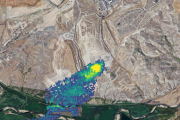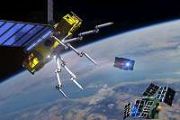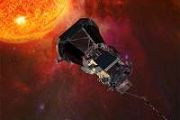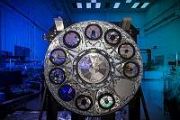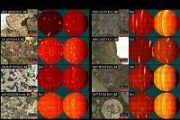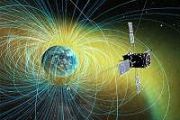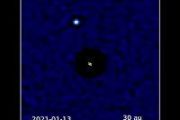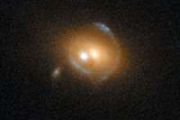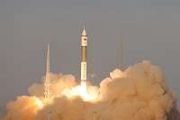
Copernical Team
China's space station to drive over 1000 research projects
 China's space station is set to conduct over 1,000 research projects, advance scientific literacy, and foster international partnerships over the next decade and beyond, according to the Technology and Engineering Center for Space Utilization under the Chinese Academy of Sciences.
As a hub for national space research, the station aims to facilitate comprehensive interdisciplinary studies,
China's space station is set to conduct over 1,000 research projects, advance scientific literacy, and foster international partnerships over the next decade and beyond, according to the Technology and Engineering Center for Space Utilization under the Chinese Academy of Sciences.
As a hub for national space research, the station aims to facilitate comprehensive interdisciplinary studies, Constellr launches first satellite pioneering global thermal monitoring
 constellr, a European leader in Earth Observation (EO), has successfully launched its first satellite, Sky-Bee-1, equipped with thermal infrared technology to monitor global land surface temperatures with unparalleled precision. This achievement marks the initial phase of its High-precision Versatile Ecosphere (HiVE) satellite constellation, aiming to deliver critical insights for sustainable re
constellr, a European leader in Earth Observation (EO), has successfully launched its first satellite, Sky-Bee-1, equipped with thermal infrared technology to monitor global land surface temperatures with unparalleled precision. This achievement marks the initial phase of its High-precision Versatile Ecosphere (HiVE) satellite constellation, aiming to deliver critical insights for sustainable re H3 Shenzhou-19 astronauts advance experiments aboard Tiangong space station
 China's Shenzhou-19 crew on the Tiangong space station has undertaken several important scientific experiments since the start of 2025, including a test involving a pipeline inspection robot, as reported by the China Manned Space Agency (CMSA).
The astronauts conducted the experiment by placing the robot within a simulated pipeline, activating it, and pressing the task button to initiate i
China's Shenzhou-19 crew on the Tiangong space station has undertaken several important scientific experiments since the start of 2025, including a test involving a pipeline inspection robot, as reported by the China Manned Space Agency (CMSA).
The astronauts conducted the experiment by placing the robot within a simulated pipeline, activating it, and pressing the task button to initiate i The new era of infrastructure maintenance using satellite data
 The rapid growth of urban populations is intensifying challenges in maintaining critical infrastructure, exacerbated by extreme weather conditions. Large-scale facilities, such as waste landfills, face particular hurdles as managers struggle with on-site access and oversight. These limitations contribute to issues such as environmental degradation and inefficient operations.
To address the
The rapid growth of urban populations is intensifying challenges in maintaining critical infrastructure, exacerbated by extreme weather conditions. Large-scale facilities, such as waste landfills, face particular hurdles as managers struggle with on-site access and oversight. These limitations contribute to issues such as environmental degradation and inefficient operations.
To address the The Tyranny of the VC Equation Why Your Company Might Not Be "VC-able"
 TL;DR: There are many great startup companies that may generate significant returns, but most of them don't pass the difficult threshold of being VC investable because their return profile doesn't close the "VC equation."
Most people in the space industry are familiar with the concept of tyranny when trying to leave the planet, especially as so eloquently summarized by Austin Morris in a b
TL;DR: There are many great startup companies that may generate significant returns, but most of them don't pass the difficult threshold of being VC investable because their return profile doesn't close the "VC equation."
Most people in the space industry are familiar with the concept of tyranny when trying to leave the planet, especially as so eloquently summarized by Austin Morris in a b Slingshot Aerospace to enhance USSF technology for GPS jamming and spoofing detection
 Slingshot Aerospace, a leader in AI-driven satellite tracking and space traffic solutions, has secured $1.9 million from the United States Space Force's (USSF) Space Systems Command (SSC) to advance its capabilities in detecting and geolocating GPS jamming and spoofing threats. These tactics, often employed in conflict zones, undermine technology effectiveness and may signal future security thre
Slingshot Aerospace, a leader in AI-driven satellite tracking and space traffic solutions, has secured $1.9 million from the United States Space Force's (USSF) Space Systems Command (SSC) to advance its capabilities in detecting and geolocating GPS jamming and spoofing threats. These tactics, often employed in conflict zones, undermine technology effectiveness and may signal future security thre Research advances towards orbital manufacturing capabilities
 Researchers from a leading Scottish university are making strides toward a future where orbital factories can manufacture advanced technology on demand in space.
Dr Gilles Bailet, from the University of Glasgow's James Watt School of Engineering, has received a patent for a novel system designed to overcome the technical challenges of 3D printing in zero-gravity environments. This innovati
Researchers from a leading Scottish university are making strides toward a future where orbital factories can manufacture advanced technology on demand in space.
Dr Gilles Bailet, from the University of Glasgow's James Watt School of Engineering, has received a patent for a novel system designed to overcome the technical challenges of 3D printing in zero-gravity environments. This innovati Webb observes expanding carbon-rich dust shells in star system
 Astronomers have made significant progress in understanding how carbon, an element vital for life, is dispersed throughout the cosmos. Using NASA's James Webb Space Telescope, scientists have taken a closer look at Wolf-Rayet 140, a system of two massive stars in the Milky Way that serves as a dynamic source of carbon-rich dust.
When the stars in Wolf-Rayet 140 approach one another in thei
Astronomers have made significant progress in understanding how carbon, an element vital for life, is dispersed throughout the cosmos. Using NASA's James Webb Space Telescope, scientists have taken a closer look at Wolf-Rayet 140, a system of two massive stars in the Milky Way that serves as a dynamic source of carbon-rich dust.
When the stars in Wolf-Rayet 140 approach one another in thei Penn State center awarded NASA grant to search for alien civilizations
 Researchers at the Penn State Extraterrestrial Intelligence (PSETI) Center have been awarded a three-year, $480,000 grant under the NASA Exoplanets Research Program to search for radio and laser signals from alien civilizations. The project is led by Pinchen Fan, a doctoral student in astronomy, astrophysics and astrobiology, under the supervision of her adviser, Jason Wright, professor of astro
Researchers at the Penn State Extraterrestrial Intelligence (PSETI) Center have been awarded a three-year, $480,000 grant under the NASA Exoplanets Research Program to search for radio and laser signals from alien civilizations. The project is led by Pinchen Fan, a doctoral student in astronomy, astrophysics and astrobiology, under the supervision of her adviser, Jason Wright, professor of astro How Many Black Holes Are Hidden Behind Clouds of Dust
 Multiple NASA telescopes have contributed to a new study exploring the prevalence of supermassive black holes, focusing on those obscured by dense clouds of gas and dust. This comprehensive survey stands out for its ability to detect these hidden cosmic giants alongside their more visible counterparts.
Scientists have long theorized that nearly every large galaxy houses a supermassive blac
Multiple NASA telescopes have contributed to a new study exploring the prevalence of supermassive black holes, focusing on those obscured by dense clouds of gas and dust. This comprehensive survey stands out for its ability to detect these hidden cosmic giants alongside their more visible counterparts.
Scientists have long theorized that nearly every large galaxy houses a supermassive blac 









